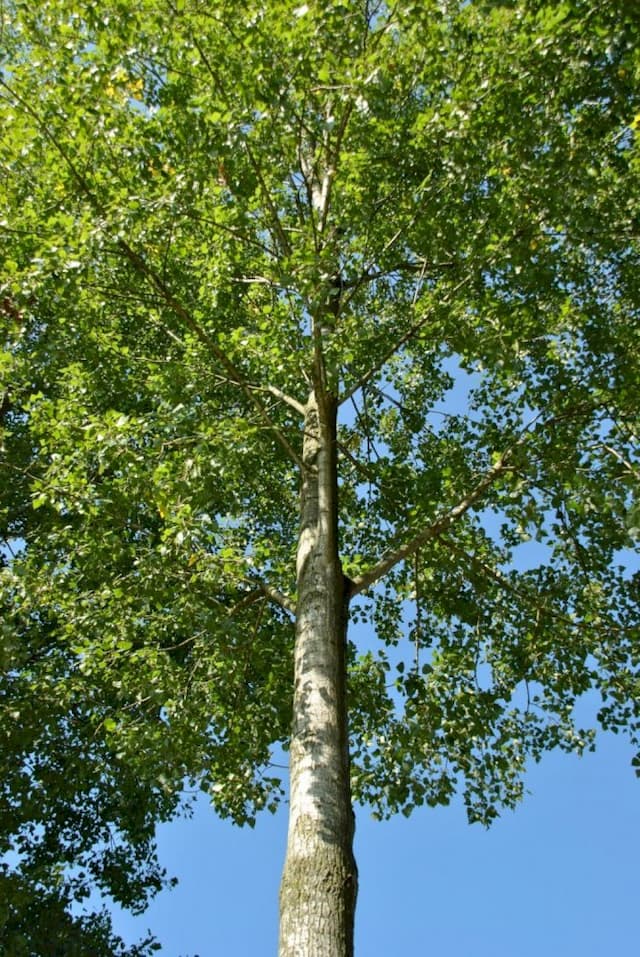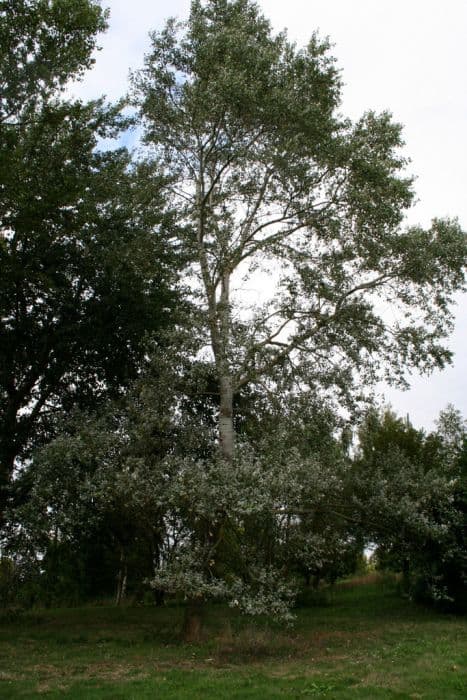European aspen Populus tremula



ABOUT
The common aspen is a deciduous tree that typically grows to a height of 80 feet tall with a trunk up to 2-3 feet in diameter. The bark of the tree is smooth and greenish-white when young, becoming grayish-white and deeply fissured as the tree ages.
The leaves of the common aspen are simple, alternate, and about 2-4 inches long and 1-2 incheswide. They are oval or triangular-shaped, with a pointed tip and a slightly heart-shaped base. The leaves are green on top and pale green on the bottom and have a flattened petiole (stem). They flutter easily in the slightest breeze, which gives it its common name: quaking aspen.
In the fall, the leaves turn yellow before falling off. The tree also produces small, inconspicuous, greenish-yellow flowers in the spring, which are followed by small, cottony seeds.
Common aspen is found in North America, specifically in Canada and the US, and can be found in many different types of forest and woodland habitats, including coniferous and mixed forests, as well as on rocky outcrops and streambanks. It is also a popular ornamental plant in landscaping.
About this plant
 Names
NamesFamily
Salicaceae
Synonyms
Aspen, Common aspen, Eurasian aspen, European aspen, Quaking aspen, Aps, Asp, Haps tree, Trembling tree
Common names
Salix tremula, Populus alba, Populus tremulifolia, Populus canescens, Populus tremuloides, Populus tremuloides var. grandidentata, Populus tremula var. tremula, Populus tremula var. glabra, Populus tremula var. intermedia, Populus tremula var. pendula
 Toxicity
ToxicityTo humans
Common aspen is not toxic to humans.
It is not known to cause any adverse effects when consumed or touched by humans. However, some individuals may have a personal intolerance to the tree, and may experience allergic reactions or skin irritation upon contact with it.To pets
Common aspen is not considered toxic to animals.
Some animals such as deer, elk, and beaver are known to eat the leaves, twigs, and bark of the tree without any known adverse effects. It is not known to cause any toxicity in animals.
 Characteristics
CharacteristicsLife cycle
Perennials
Foliage type
Deciduous
Color of leaves
Green, yellow shades in fall
Height
Up to 80 feet
Spread
Up to 80 feet
Plant type
Tree
Hardiness zones
1
Native area
Europe, Asia, and North America
Benefits
 General Benefits
General BenefitsThe leaves, twigs, and bark of the aspen tree provide food for a variety of animals such as deer, elk, and beaver;
The tree's extensive root system helps to hold the soil in place and prevent erosion;
Aspen trees release water vapor and provide shade, which cools the air and reduces the urban heat island effect;
Aspen trees are known for their beautiful autumn foliage and can be used as an ornamental tree in gardens and parks;
Aspen is used for pulp production and wood products, such as furniture, flooring, and construction materials;
Aspen trees absorb and store carbon, helping to mitigate the effects of climate change;
Aspen groves provide beautiful and peaceful setting for hiking, camping, and other outdoor activities. Medical Properties
Medical PropertiesCommon aspen has been traditionally used in some cultures for its medicinal properties.
Some of the traditional medicinal uses of aspen incluAspen bark was traditionally used as a pain reliever for headaches, toothaches and other types of pain;
Aspen bark was used to treat skin conditions such as psoriasis, eczema, and wounds;
Aspen bark was used as a treatment for respiratory conditions such as asthma and bronchitis;
Aspen bark was used to treat anxiety and sleep disorders.
It's important to note that aspen should not be used as a substitute for prescribed medications and consulting with a healthcare professional before using it. Other Uses
Other UsesAspen wood is used to make the soundboards of some string instruments like violins, violas and cellos, due to its light weight and good vibrational properties;
Aspen wood is also used to make matchsticks due to its high ignition point and ability to burn hot and steady;
Aspen wood is also used to make clogs, a type of wooden shoe traditionally worn in rural areas of Europe and Asia;
In some cultures, aspen wood is used to make ritual objects such as wands, staffs, and amulets;
Aspen bark is also used to make a tea that is believed to have medicinal properties;
In some places, Aspen is used to create biofuel.
Interesting Facts
 Plant Symbolism
Plant SymbolismThe tree reproduces itself by sending up new shoots from its roots, so it is seen as a symbol of rebirth and rejuvenation;
Aspens are known for their ability to grow in dense groves, providing protection and shelter for other plants and animals;
Aspen trees are known for their ability to survive in harsh conditions, which makes them a symbol of strength and resilience;
These trees are known for their ability to grow in dense groves and share a single root system, which makes them a symbol of community and interconnectedness;
The leaves of the aspen tree are known for their ability to tremble or quiver in the slightest breeze, this feature make them a symbol of sensitivity and responsiveness to change.
 Water
WaterProper watering is an important aspect of caring for Common aspen.
When watering your aspen tree, it's important to water deeply to encourage deep root growth. Watering deeply means to apply water slowly, allowing it to seep down to the roots of the tree, instead of just watering the surface.
Aspen trees prefer a consistent level of moisture in the soil, so it's important to water regularly. This frequency will depend on the weather and the soil conditions, but typically, it's a good idea to water your aspen tree once a week.
Aspen trees need about 1-1.5 inches of water per week, which can be achieved through watering or rainfall. Light
LightCommon aspen prefers full sun, but can also tolerate partial shade.
It will grow best in a location that receives at least six hours of direct sunlight per day. Temperature
TemperatureCommon aspen is hardy in USDA plant hardiness zones 2 and higher, which covers most regions of the world.
Common aspen can survive in temperatures as low as minus 40 degrees Fahrenheit and as high as 100 degrees Fahrenheit. It can tolerate low temperatures and can survive in colder climates. Pruning
PruningPruning is not necessary for common aspen, but if you want to control the size or shape of the tree, it's best to prune it in late winter or early spring before new growth begins. When pruning, make sure to remove dead, diseased or damaged wood, and to thin out the crown to promote better air circulation and sunlight penetration.
 Soil
SoilCommon aspen can grow well in various types of soils and moist environments, but it prefers well-draining soils with a neutral pH (around 7.0).
It can tolerate a wide range of soil conditions, but it will grow best in soils that are rich in organic matter and have a good water-holding capacity. Repotting
RepottingCommon aspen is a fast-growing tree and may outgrow its container (if the plant is growing in a container).
Depending on the size of the container and the growth rate of the tree, you may need to repot it every 2 to 3 years. It's best to repot in spring or early summer, when the tree is actively growing. Humidity & Misting
Humidity & MistingCommon aspen prefers a moderate level of humidity, but can tolerate a wide range of humidity levels. It can grow well in both dry and moist environments.
 Suitable locations
Suitable locationsIndoor
Common aspen is a tree that is mostly grown in soil in the open ground.
If you want to grow common aspen indoors, it's best to provide it with bright, indirect light and to keep the soil moist but not waterlogged. It's also important to protect your flooring and furniture, as the tree can drop leaves, twigs, and bark.Outdoor
If you want to grow common aspen outdoors, it's best to plant it in a location that receives full sun to partial shade and has well-draining soil. It's also important to provide it with enough water and to protect it from extreme temperatures, if you live in areas with harsh winter or hot summer.
Hardiness zone
USDA 2 - 10
 Life cycle
Life cycleThe first stage of the Common aspen's life cycle begins when the seeds germinate in the soil, usually in the spring. Germination is triggered by the presence of light and water, as well as favorable temperatures. Germinated seedlings will grow into a small plant, with a single stem and a small set of leaves.
During the vegetative growth stage, the aspen tree will continue to grow taller and produce more leaves, as well as a deep root system. This stage can last for several years.
Aspen trees are known for reproducing both sexually and vegetatively. During the sexual reproduction stage, the tree will produce flowers (catkins) and seeds, which can be dispersed by the wind. The seeds will germinate and grow into new trees, starting the life cycle again.
Aspen trees have a relatively short lifespan of around 40-150 years, but they can live up to 200 years in ideal conditions. When the tree dies, it will lose its leaves and its bark will become rough and cracked. The tree will continue to stand for some time, but eventually it will fall to the ground, and its trunk and branches will decompose, returning nutrients to the soil. Propogation
PropogationPropogation time
Spring - early summer
By SEEDS:
The most common method of propagation is through seed, which can be collected from the tree in the fall and sown in the spring. Germination typically occurs within a few weeks, but it may take up to a year for seedlings to become established.
By CUTTINGS:
Common aspen can also be propagated through cuttings taken from the tree in the spring. Cuttings should be about 6 inches long, and should be planted in moist soil or a rooting hormone can be used to promote rooting.
By ROOT SUCKER:
Common aspen can also be propagated through root suckers, which are shoots that grow from the roots of the tree. Root suckers can be dug up and transplanted to a new location.
 Pests
PestsAphid, Caterpillar, Aspen leaf miner, Aspen bark beetle
 Diseases
DiseasesRoot Rot, Powdery mildew, Aspen cankers, Aspen rust









